
Ceiba pentandra is a tropical tree of the order Malvales and the family Malvaceae, native to Mexico, Central America and the Caribbean, northern South America, and West Africa. A somewhat smaller variety was introduced to South and Southeast Asia, where it is cultivated.

Dimocarpus longan, commonly known as the longan, is a tropical tree species that produces edible fruit. It is one of the better-known tropical members of the soapberry family Sapindaceae, to which the lychee and rambutan also belong. The fruit of the longan is similar to that of the lychee, but less aromatic in taste. It is native to tropical Asia and China.

The jackfruit, also known as jack tree, is a species of tree in the fig, mulberry, and breadfruit family (Moraceae). Its origin is in the region between the Western Ghats of southern India, all of Bangladesh, Sri Lanka, and the rainforests of the Philippines, Indonesia, and Malaysia.
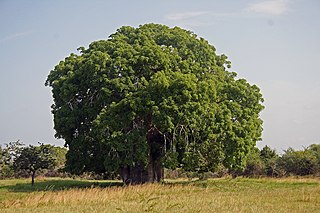
Adansonia is a genus made up of eight species of medium-to-large deciduous trees known as baobabs. They are placed in the Malvaceae family, subfamily Bombacoideae. They are native to Madagascar, mainland Africa, and Australia. The trees have also been introduced to other regions such as Asia. The generic name honours Michel Adanson, the French naturalist and explorer who described Adansonia digitata. The baobab is also known as the "upside down tree", a name that originates from several myths. They are among the most long-lived of vascular plants and have large flowers that are reproductive for a maximum of 15 hours. The flowers open around dusk, opening so quickly that movement can be detected by the naked eye, and are faded by the next morning. The fruits are large, oval to round and berry-like and hold kidney-shaped seeds in a dry, pulpy matrix.
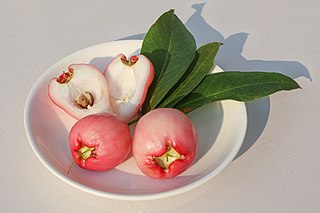
Syzygium samarangense is a species of flowering plant in the family Myrtaceae, native to an area that includes the Greater Sunda Islands, Malay Peninsula and the Andaman and Nicobar Islands, but introduced in prehistoric times to a wider area and now widely cultivated in the tropics. Common names in English include wax apple, Java apple, Semarang rose-apple and wax jambu.

Ficus microcarpa, also known as Chinese banyan, Malayan banyan, Indian laurel, curtain fig, or gajumaru (ガジュマル), is a tree in the fig family Moraceae. It is native in a range from China through tropical Asia and the Caroline Islands to Australia. It is widely planted as a shade tree and frequently misidentified as F. retusa or as F. nitida.

Manilkara zapota, commonly known as sapodilla, sapote, naseberry, nispero or chicle, is a long-lived, evergreen tree native to southern Mexico, Central America and the Caribbean. An example natural occurrence is in coastal Yucatán in the Petenes mangroves ecoregion, where it is a subdominant plant species. It was introduced to the Philippines during Spanish colonization. It is grown in large quantities in Mexico and in tropical Asia including India, Pakistan, Thailand, Malaysia, Cambodia, Indonesia, Vietnam, Bangladesh.

Pandanus tectorius is a species of Pandanus (screwpine) that is native to Malesia, Papuasia, eastern Australia, and the Pacific Islands. It grows in the coastal lowlands typically near the edge of the ocean. Common names in English include thatch screwpine, Tahitian screwpine, hala tree and pandanus. The edible fruit is sometimes known as hala fruit.

Borassus is a genus of five species of fan palms, native to tropical regions of Africa, Asia and Papua New Guinea.

Jabuticaba is the edible fruit of the jabuticabeira or Brazilian grapetree. The purplish-black, white-pulped fruit grows directly on the trunk of the tree. It is eaten raw or used to make jellies, jams, juice or wine. The tree, of the family Myrtaceae, is native to the states of Rio de Janeiro, Minas Gerais, Goiás and São Paulo in Brazil. Related species in the genus Myrciaria, often referred to by the same common names, are native to Brazil, Argentina, Paraguay, Peru and Bolivia.

The tembusu is a large evergreen tree in the family Gentianaceae, native to Southeast Asia. It is the Malay name for Cyrtophyllum fragrans.

Syzygium luehmannii is a medium-sized coastal rainforest tree native to Australia. Common names include riberry, small leaved lilly pilly, cherry satinash, cherry alder, or clove lilli pilli.
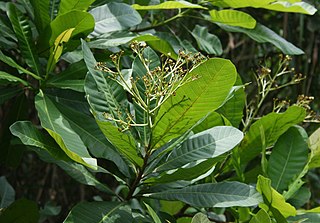
Anacardium excelsum, the wild cashew or espavé, is a tree in the flowering plant family Anacardiaceae. The tree is common in the tropical and subtropical dry broadleaf forests of Pacific and Atlantic watersheds of Central and South America, extending as far north as Guatemala and south into Ecuador.

Englerophytum magalismontanum, commonly known as stamvrug, is an evergreen tree that mostly grows in rocky places. It has an extensive range, from northern KwaZulu-Natal northwards along the east coast and into the southern African interior, and northwards into tropical Africa.

Mangifera zeylanica or "Sri Lanka wild mango" is a wild species of mango tree endemic to Sri Lanka. This stately tree is the tallest member of the mango genus, Mangifera, and one of the two tallest trees in the family Anacardiaceae. The mango fruits are edible and have an excellent taste. It is called "aetamba" (ඇටඹ) or "wal amba" in Sinhala and “kaddu-ma” in Tamil. The well-known British botanist and explorer Joseph Dalton Hooker first described the tree in 1876.

Caryota urens is a species of flowering plant in the palm family, native to Sri Lanka, India, Myanmar and Malaysia, where they grow in fields and rainforest clearings, it is regarded as introduced in Cambodia. The epithet urens is Latin for "stinging" alluding to the chemicals in the fruit. Common names in English include solitary fishtail palm, kitul palm, toddy palm, wine palm, sago palm and jaggery palm. Its leaf is used as fishing rod after trimming the branches of the leaf and drying. According to Monier-Williams, it is called moha-karin in Sanskrit. It is one of the sugar palms.

Semecarpus australiensis, commonly known as the tar tree, native cashew, marking nut, or cedar plum, is a species of tree in the cashew, sumac and mango family Anacardiaceae, native to parts of Melanesia and northern Australia. Contact with the plant can cause serious allergic reactions, a common characteristic of this family.
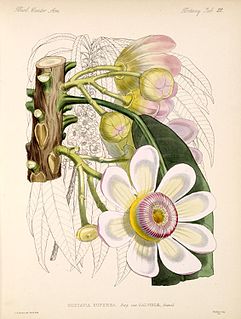
Gustavia superba is an understory tree that grows in Central and north-western South America. Common names include membrillo, sachamango and heaven lotus. The trunk is around 5-10m high with the leaves radiating from the top.
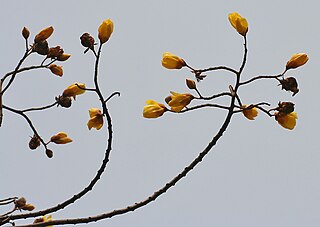
Cochlospermum religiosum is a flowering plant from the tropical region of Southeast Asia and the Indian Subcontinent. It is a small tree growing to a height of 7.5 m (25 ft) usually found in dry deciduous forests. The name religiosum derives from the fact that the flowers are used as temple offerings. It is also known as silk-cotton tree because the capsules containing the seeds have a fluffy cotton-like substance similar to kapok. Another common name is buttercup tree because its yellow and bright flowers look like large-sized buttercups.
Aubrevillea kerstingii is a large tree within the Fabaceae family. It occurs in semi-deciduous forests, gallery forests and also found in the savannah woodland zones of West and Central Africa.





















